The Fitbit Alta HR band is the least dorky fitness band you can buy
Yes, we know we should move more, sleep better, eat right. But unless you’re wearing a fitness tracker, the results of your efforts are essentially invisible. Trackers keep your progress in your face, a benevolent Little Brother always cheering you on.
That’s especially true of the new Fitbit Alta HR ($150), a spectacular little device that reviewers are already calling the best fitness tracker ever.
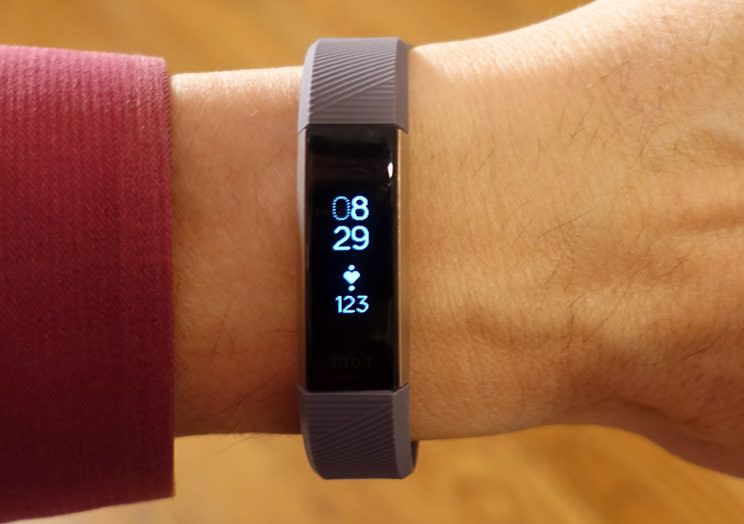
I’m among them. This amazingly thin, stylish band smoothly and reliably tracks your steps, calories, and sleep. You can swap it onto other bands of different colors and materials. Its battery lasts a full week. [Update: Mine routinely lasts 9 days.] Its companion app is terrific.
Above all, the Alta HR is the slimmest tracker ever made with continuous heart-rate tracking. That, really, is the headline. (The original Alta didn’t have heart-rate monitoring.)
Why we care about heart rate
Heart rate is an important indicator of your overall metabolism, how efficiently you’re exercising, and how healthy your heart is overall (your resting heart rate). The Alta uses your pulse data to produce more accurate calorie-burn statistics, too.
And for the first time in a Fitbit, the heart data also informs the sleep data. When you wake in the morning, you can actually see a graph of your sleep cycles, with explanations of how to interpret them.

For example, your heart tends to beat the most steadily when you’re in deep sleep, which is tied to memory, learning, and physical recovery. Its rate is much more variable during REM (rapid eye-movement) sleep, which helps with memory and mood. Light sleep, which helps restore you mentally and physically, is in between. Fitibit’s software combines your pulse information with your movement data to determine what phase of sleep you’re in.
Better yet, the app soon begins to offer you daily observations about your particular sleep and activity habits (above, right). “You got 20 minutes more sleep on days you ran, versus days you didn’t,” it might say. Life and health coaching, yours free.

These improved sleep features will be coming soon to other Fitbits that have heartbeat sensors.
What isn’t new
What’s new in the Alta HR are the heart sensor, the better battery, and a much improved buckle (rather than the fussy pegs-and-holes clasp of the previous Alta).

The rest of the Alta HR story should be familiar to Fitbit fans. For example:
A superior app. The Fitbit app is a model of infographics. They should use it in “How to present a lot of information without becoming un-navigable” classes. With a tap or two, you can reveal your sleep, steps, calories, activity, food, and water stats for today (or by the week, month, or year).
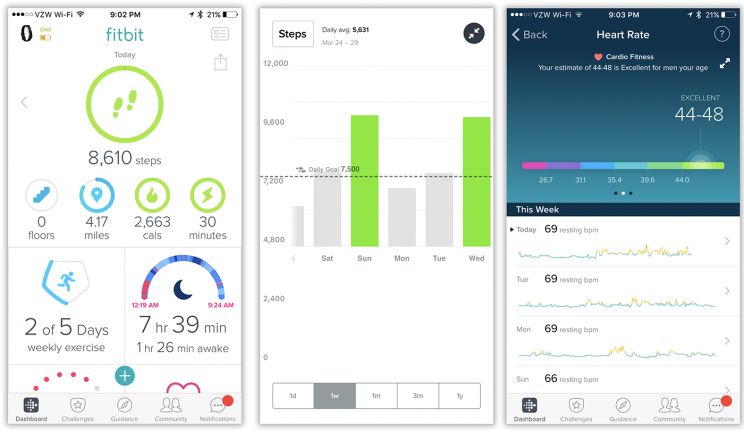
Social features. The app is also the hub for participating in competitions with other Fitbit fans—a great motivator. (The adorable 10-year-old daughter of an old friend in London keeps challenging me to weekly step-count races. I keep losing.) In an update this week, Fitbit made it easy for you to join groups of like-minded health nuts; you can boast about your achievements and ask questions.
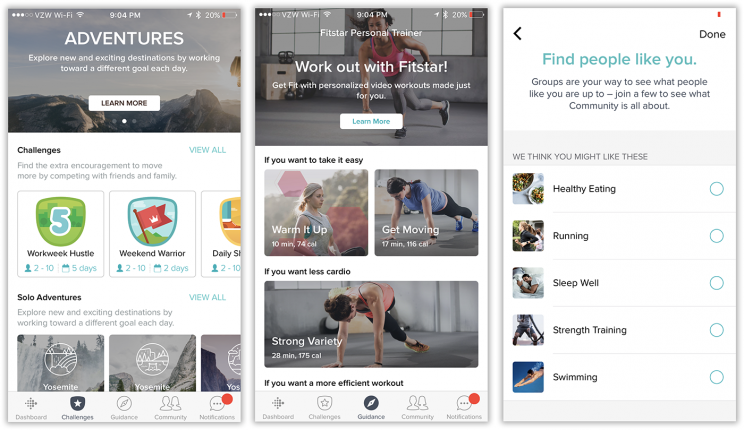
Motivational features. Fitbit’s app uses clever cues to prod you to move more, and reward you when you do. For example, Adventures is a cool, semi-augmented-reality feature: As your step count grows through the week, it tracks where you’d be if you’d walked the same distance into the hiking paths in Yosemite, or the route in the New York City Marathon. You can hold your phone up and look around, turning your body, and see the stunning view that you’d see around you—no matter how gritty and depressing your actual location.
Swappable bands. You can pop out the Alta’s brain module to insert it into a different band: another silicone color ($30) or a leather one ($60). (There are also dozens of great bands for sale on Amazon—for as little as $10.) There’s even a gorgeous, shiny, stainless-steel, bangle-type band ($100) that takes fitness trackers into a whole new realm of jewleryishness—but, because it’s a bangle that dangles away from your wrist, sacrifices the heart monitoring. The new bands are interchangeable with the original Alta—which means that you if you own the original Alta, you can now get the better buckle mechanism.
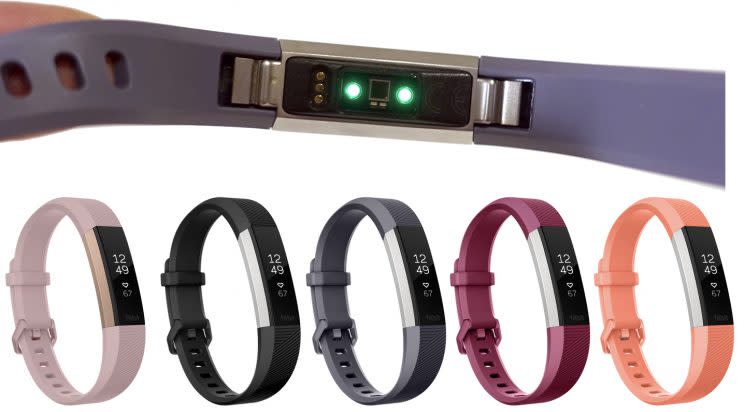
OLED screen. The OLED screen isn’t as bright as the one on the Fitbit Charge 2; you can’t see it at all in direct sunlight. You can choose what kind of time display you want, and in which orientation.
Showerproof (shhhhhh!). Fitbit, no doubt fearing complaints from people whose showers are modeled after fire hoses, discourages you from wearing the Alta in the shower. (It’s splash- and rain-resistant only, they say.) But the truth is that it does fine in showers of typical water pressure; I’ve been violating Fitbit’s no-shower recommendation for years without a problem.
Multiple readouts. The screen is ordinarily dark. To see the time, you have to double-tap the screen or just raise your wrist. Once you’ve awakened the Alta, each additional screen tap summons a different tally for the day: Steps, miles, calories burned, minutes active, battery life. (It’s not a touchscreen. The Alta detects your taps solely by feeling the jostling of the entire unit.)
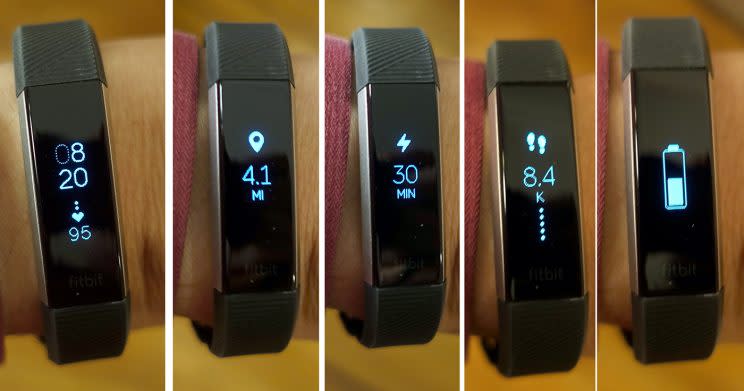
Notifications. The Alta vibrates when your phone gets an incoming call or text—it scrolls the actual text message—or when a calendar appointment comes due. (You can turn off any of these notifications.) Super handy when your phone is buried in your bag or over there on the table.
Silent alarms. Your band can awaken you quietly, with a wrist vibration. Handy if your bed partner sleeps later than you do.
Workout detection. The Alta, like other Fitbits, can detect when you’re exercising, and record it correctly. By analyzing the particular movement patterns of your wrist, it knows which kind of exercise you’re doing: biking, hiking, running, or playing basketball, soccer, or tennis. It automatically records that exercise, which is really slick.
Reminders to move
Many studies have established how deadly it is to sit for long periods. It’s really terrible for you. Sit six hours a day, and you’ll die 4.8 years sooner, according to a 2012 study. That’s true even if you exercise regularly; this article explains why.
One study, however, says that just moving a little once every hour goes a long way toward fighting off those awful outcomes. That’s why the Alta reminds you, after every hour of sitting, to walk around for a couple of minutes.
You can turn off this feature, and you can set up “Do not disturb” times when you won’t be nagged. But man, this feature really, truly works. I found that I didn’t have to think very hard to come up with an hourly excuse to get up and go do something, thus making my app happy.
Alta HR vs the rest
I wasn’t especially thrilled by the original Alta, which seemed to be a big step down from the industry’s smarter (but bigger) bands.
But the Alta HR is a different story. The heart monitor enhances the accuracy of many other data types, including calorie tracking, weight-loss tracking, exercise tracking, and sleep tracking.
Yet all of this still fits into a sleek, thin, non-dorky-looking band.
Fitbit’s representatives mentioned to me, with a hint of pride, that getting its optical heart-rate sensor shrunken down into a band this slim—and yet fitting a larger battery than the first Alta’s—was an enormous technical challenge.

That may be why, surprisingly, the Alta costs the same $150 as its older, wider brother, the Charge 2, which I reviewed here—even though the Charge 2 does more. Just so you know, here’s what the Charge 2 does that the Alta HR does not:
Stairway counting. The Alta HR has no altimeter. (The Alta HR therefore needs no little air hole—another reason it’s weird that Fitbit says not to wear it in the shower.)
Guided relaxation breathing, guided workouts. The Alta’s screen isn’t wide enough to display the animations, and the Alta lacks the physical button for navigating those features.
“Connected GPS.” That’s where the Fitbit tracks your runs or bike rides by consulting your phone’s GPS, so that you can review your route in the Fitbit app later.
In other words, if you’re a serious athlete, the Alta probably won’t be enough for you. But if you’re just aiming to get healthier, sleep better, lose weight, and gain amazing insight into the ordinarily invisible processes of your body and metabolism, the Alta is the best band going.
More from David Pogue:
David Pogue’s search for the world’s best air-travel app
David Pogue tested 47 pill-reminder apps to find the best one
The little-known iPhone feature that lets blind people see with their fingers
I paid $3,000 for my MacBook Pro and got emotional whiplash
Here’s the real money-maker for the Internet of Things
David Pogue, tech columnist for Yahoo Finance, welcomes non-toxic comments in the Comments below. On the Web, he’s davidpogue.com. On Twitter, he’s @pogue. On email, he’s poguester@yahoo.com. You can read all his articles here , or you can sign up to get his columns by email.

